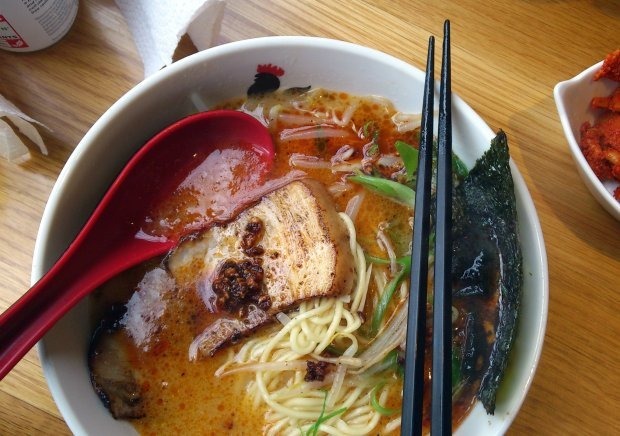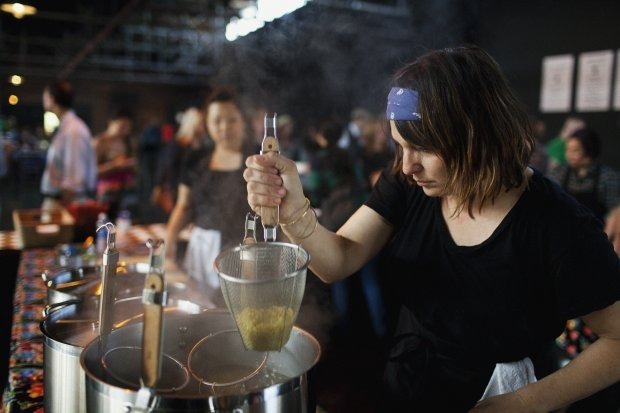It's Cool To Slurp Now
In June, Food Republic is counting the many reasons to love Asian food in America right now. Here's one of them.
In the old days, your mother would probably scold you for making such horrible noises at suppertime: Slurping your soup was considered poor table manners in polite American society, an egregious faux pas memorably (and quite audibly) sent up in the 1985 crime-comedy Clue. Nowadays, amid the growing influence of Asian food and Asian customs in this country, your dining companions might hardly wince at these loud sucking sounds. On the contrary, they might just join in the ruckus. In some of today's more fashionable locales, slurping is not merely accepted. It's downright proper.
"I want people to slurp," says Ivan Orkin, the American-born chef who notably rose to fame within Tokyo's insular ramen scene, where it's quite customary for patrons to hungrily hoover their noodle soups without shame or fear of offending any grimacing prudes within earshot. "It's much more enjoyable when you slurp it up," says Orkin. "You get a mouthful of noodles all coated in soup."
Orkin is such a slurping proponent that he put the sloshy word right in the title of his first U.S. restaurant, located inside New York City's Gotham West Market: the Ivan Ramen Slurp Shop. And at his flagship restaurant, Ivan Ramen, on Manhattan's Lower East Side, an expansive, anime-style art installation colorfully illustrates "The Art of the Slurp," with repeated emphasis on the onomatopoeia of it all: "SLURRRP!"
Beyond the mere amusement factor, Orkin says there is wisdom in slurping. It's all about quality control, ensuring that your ramen noodles are eaten at the perfect temperature — hot, but not too hot, he explains. Less savvy diners might be inclined to just sit tight while the steaming vessel in front of them cools down to a less palate-scalding degree. This is wrong, he says: "If you wait for ramen to cool down, the fat congeals and the noodles get soft and the soup loses some of its luster. When it's real hot, the fat is all liquidy and the chashu is tender and soft and warm and the noodles have a perfect bite. By being able to slurp, you cool the soup off a little bit so you can eat it while it's still hot, and you get a mouthful of noodles that are al dente, like they're supposed to be."

But what about the noise? To Orkin, the inelegant way that many naïve Americans approach ramen is far more off-putting. "People wouldn't eat spaghetti Bolognese the way I see some people eating ramen," he says. "Like, chewing half of it and then spitting it back into the bowl, then eating some more and spitting the rest back into the bowl. I think people don't realize how funny that looks. To me, it's more uncouth to let food dangle out of your mouth than it is to slurp and make some noise."
Besides, within the context of today's notoriously noisy restaurant scene, who can even hear it? During dinner one recent evening at Orkin's lively flagship, the decibel meter on this writer's smartphone hovered around 91, on par with the average food blender. Amid the din of chattering diners and the Bee Gees' 1976 disco hit "You Should Be Dancing" blaring in the background, any otherwise obnoxious slurping sounds barely registered.
It's a far cry from the typically serene scene at traditional ramen shops in Tokyo. "Shops are never noisy," says fellow American ramen entrepreneur Sarah Gavigan, who ate extensively during her travels in Japan just last year. "You hear everybody slurping. That's all you hear, really."
Like Orkin, Gavigan is a big believer in the basic decency of slurping. "It's kind of a sign of joy to me when you just go facedown into a bowl of noodles and you're slurping and you're not talking and you don't care what anybody else thinks," says Gavigan, who developed her own love for sucking up ramen noodles over the nearly two decades she spent living in Los Angeles, eating in Japanese restaurants where she was often the only gaijin (Caucasian) and learning the correct suction technique by watching legit slurpers in action. Conventional slurp-averse Americans are missing out on a big part of the ramen experience, Gavigan says: "You do get that olfactory sensory portion of the meal that you don't get otherwise. The circulation of the air, combined with the oils and the aromas, it just brings it to another level. You're sensing things that you wouldn't sense if you just bite on it."

These days, Gavigan is helping to spread the ramen gospel in her native Nashville. In 2013, she launched her own roving ramen pop-up, Otaku South, setting up shop at the local farmers' market and at popular restaurants, including the acclaimed Catbird Seat, en route to opening a bona fide restaurant, Otaku Ramen, which is scheduled to debut this coming fall. With its rapidly emerging food scene, Music City is a welcoming place for trendy dining concepts. And to hear Gavigan tell it, locals have been quick to embrace the growing ramen craze. But as for its most uproarious custom? Not so much. "Southerners do not slurp," she says.
In a city with little to no Asian population, Gavigan notes, getting people to cast aside the etiquette lessons of their debutante days in favor of an entirely foreign custom is a pretty hard sell. But Gavigan is undaunted. Educating customers on the right way to eat ramen will be a major focus of her new restaurant, she says. And she's encouraged by the way modern American youths, including many in Middle Tennessee, have latched on to Japanese pop culture, which is full of references to food customs and ramen in particular.
"I have, like, 15 twentysomethings working in my restaurants; over half of them read Japanese graphic novels and slurp — slurp, slurp, slurp," she says.

